Home » Sports Field Lighting » LED Tennis Court Lighting Layout & Design Guide
LED Tennis Court Lighting Layout & Design Guide

To enjoy any sport to the fullest, you must meet its lighting requirements. Fortunately, there are various types of field lighting systems for you to choose from. Tennis is a hugely popular sport that is played on a court. It can also be played in a variety of places including indoors, outdoors, and underground.
Whether your court is located in a high school, college, university, or college, you must ensure that the tennis court lighting is well designed. If not, you will find the time you spend on the court less enjoyable. You will also find yourself paying high energy bills. Hence, the importance of having proper court lighting can’t be over-emphasized. In this article, we will be providing all the information you need on tennis court lighting.
If you are planning to install new LED lights or upgrade to LED lighting at your sports facility you can get an instant cost estimate for your project by using our tennis court lighting cost calculator.
Get Your LED Sports Lighting Project Started
We’ve created a comprehensive set of tools designed to assist facility managers and project planners in initiating their projects and connect them with the professionals in the industry.
Get a tailored cost estimate
Try our LED sports lighting cost calculator and get a customized quote in a matter of minutes.
Get a photometric study
Tell us briefly about your project and get a lighting design from a professional lighting company
Find your ideal supplier
Give us the specs of your lighting project and get a list of recommended suppliers from our network.
LED Sports Lighting Buyer's Guide
Our free buyer's guide covers planning, budgeting, design, installation, and post-installation considerations, simplifying your decision-making process.
Find Grants & Funding
Browse through our grants database and find potential funding opportunities for your lighting project.
Energy-Efficient LED Tennis Court Lighting Systems
The best type of lights used in both schools and recreational tennis courts today are LED lights. There are several reasons for you to choose LED lights over traditional lights like HIDs. To start with, LED lighting systems are incredibly energy efficient when compared to other lighting systems. You will get to cut down on your bills and save even more money over time. This is because LED lights last up to 100,000 hours and require little maintenance.
Another reason why you should opt for an LED tennis court lighting system is that it offers better light quality. LED lights improve the safety and performance of tennis players because they are halo and glare-free. The light will work in their favor regardless of the direction they look. Additionally, people staying close to the court will feel more comfortable since LED systems only direct light towards the field instead of lighting up the entire community.

LED Tennis Court Light Fixtures
The best type of lights used in both schools and recreational tennis courts today are LED lights. There are several reasons for you to choose LED lights over traditional lights like HIDs. To start with, LED lighting systems are incredibly energy efficient when compared to other lighting systems. You will get to cut down on your bills and save even more money over time. This is because LED lights last up to 100,000 hours and require little maintenance.
Another reason why you should opt for an LED tennis court lighting system is that it offers better light quality. LED lights improve the safety and performance of tennis players because they are halo and glare-free. The light will work in their favor regardless of the direction they look. Additionally, people staying close to the court will feel more comfortable since LED systems only direct light towards the field instead of lighting up the entire community.
Best LED fixtures for outdoor tennis courts
- LED floodlights are the best and most common types of fixtures used to light up tennis courts. They provide a broad and uniform light beam that is ideal for lighting up large outdoor areas.
Best LED fixtures for indoor tennis courts
- Indoor tennis courts are typically lit up with LED high bay light fixtures. They can be fairly easily mounted on the ceiling and they offer a more focused beam of light to cover the courts below. Just be mindful that the indoor arena must have a ceiling height of at least around 20 feet.
How to convert metal halide fixtures to LED tennis court lights?
If you are operating a tennis facility and want to replace your existing metal halides with LED tennis court light fixtures, you should understand how to convert the wattage between LED and metal halide lights. Here’s a brief summary:
- 100W – 200W LED tennis court light fixture replaces a 250W -400 metal halide fixture
- 200W – 400W LED tennis court light fixture replaces a 400W metal halide fixture
- 400W – 500W LED tennis court light fixture replaces a 1000W metal halide fixture
- 600W – 1000W LED tennis court light fixture replaces a 1500W metal halide fixture
- 1000W – 1200W LED tennis court light fixture replaces a 2000W metal halide fixture
If you are planning to replace your existing metal halide lights with LED tennis court light fixtures, try our tennis court lighting cost calculator to get a customized cost estimate for your project.
Examples of LED tennis court light fixtures

LED Tennis Court Light Fixture
- Tunable white lights
- 350W
- 46,000+ lumens
- CRI up to 93
- CCT 1600K-6300K

LED Tennis Court Light Fixture
- Full RGB and tunable white
- 350W
- CRI 70-90
- 1800K-10000K

LED High Mast Tennis Court Light Fixture
- Asymmetric indirect light
- 100W-200W
- CRI 70-90
- CCT 3000K-5000K

LED High Mast Tennis Court Light Fixture
- Asymmetric indirect light
- 300W-400W
- CRI 70-90
- CCT 3000K-4000K
LED Sports Lighting Buyer's Guide
If you're planning to install or retrofit an LED sports lighting system, our comprehensive buyer's guide covers all the essential aspects including planning, budgeting, design, installation, and post-installation considerations, simplifying your decision-making process.
Get the Free GuideLED Tennis Court Lighting Requirements & Standards
According to the United States Tennis Association (USTA) and Illuminating Engineering Society (IES), the right level of lighting for a tennis court depends on the level of competition. These levels are split into four broad categories:
Outdoor Tennis Court Lighting Levels
- Class I: Professional level: min. 125 foot candles / 1250 lux
- Class II: College and medium level: min. 50 foot candles / 500 lux
- Class III: High school and private clubs: min. 30 foot candles / 30 lux
- Class IV: Recreational: min. 20 foot candles / 200 lux
Indoor Tennis Court Lighting Levels
- Class I: Professional level: min. 125 foot candles / 1250 lux
- Class II: College and medium level: min. 75 foot candles / 750 lux
- Class III: High school and private clubs: min. 50 foot candles / 500 lux
- Class IV: Recreational: min. 30 foot candles / 300 lux
LED Tennis Court Lighting Layout & Design
LED tennis court lighting systems consists of several components that need to be planned and prepared properly by a professional sports lighting contractor.
- Power supply – make sure you have access to the local grid and check that the voltage and wattage of the lighting system match the power source.
- Wiring & cables – Installing a tennis court lighting system requires some wiring work from the power supply to the light fixtures and the control system. Wiring for outdoor courts needs to be protected from the elements (humidity, water, temperature changes, etc.).
- Mounting hardware and light fixtures – Outdoor tennis court lighting fixtures are mounted on light poles. Make sure you include this cost in your budget and check that there is enough space around the court for light poles. Indoor courts may use trusses or brackets attached to the ceiling/walls so that the light fixtures can be properly mounted and angled to provide uniform illumination.
- Control system – make sure to protect the control system from the elements.
There are two types of tennis courts, namely indoor and outdoor courts. The International Tennis Federation (ITF) states that a standard court should be 23.77 meters in length. However, doubles have a width of 10.97 meters while singles have a width of 8.23 meters. In this section, we will be looking at the tennis court lighting design guidelines for both types of tennis courts.

Outdoor Tennis Courts Light Arrangement
The lighting poles found in outdoor tennis courts usually have a height of between 6 to 8 meters. This height can vary depending on environmental factors. The lamps should be positioned on both sides of the net, and they should be 6 meters high. They should also offer the same amount of illumination.
Four Corner Arrangement: The light poles should be positioned at the four corners of the field.
Two-Sided Arrangement: The light poles are positioned on both sides of the field.
Mixed Arrangement: This setting involves the combination of the two-sided arrangement and four-cornered arrangement

Indoor Tennis Court Light Arrangement
Top Arrangement: The lamps are positioned above the field and the light beam is placed perpendicularly to the court’s plane.
Two-Sided Arrangement: The lamps are installed on the two sides of the court and the light beam isn’t positioned perpendicularly.
Mixed Arrangement: This involves the combination of the two-sided arrangement and top arrangement.
LED Tennis court lighting layout per competition level
The planning of the lighting layout for a tennis court starts with understanding what the use concept of the sports facility is. A recreational tennis court which is open for local residents does not have to meet the same standards a college or professional tennis court is required to meet. This is mostly due to the fact that tennis matches at a college and professional level attract big audiences in the stands and via TV broadcast. In order to provide a good quality event to the spectators, the lighting system needs to be of a very high standard.
Important requirements that vary across the different levels of play are for example:
- Brightness level
- Number of poles
- Light pole height
- Uniformity
- Glare
- Light temperature
- Color rendering index (CRI)
Below you can find typical tennis court layouts for different competition levels. You can click on them to find out more detailed information about each setup.
Outdoor LED Tennis Court Lighting Layout - Recreational and training
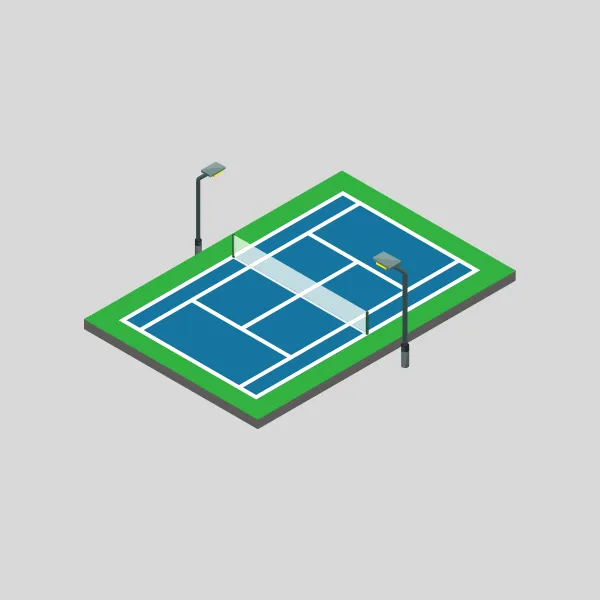
Single tennis court LED
lighting layout with
2 poles
Single tennis court LED lighting layout with 2 poles
The cost of the tennis court layout described below typically costs somewhere between $30,200 and $233,200 per court depending on the quality of the LED lighting fixutres and geographical differences.
Level of competition
Recreational
Brightness (fc/lux)
30 fc / 300 lux - 50 fc / 500 lux
Light pole height
20- 26 feet
Light temperature
Above 2000K
Uniformity
Above 0.6
Glare
Less than 55
Color rendering index
Above 20
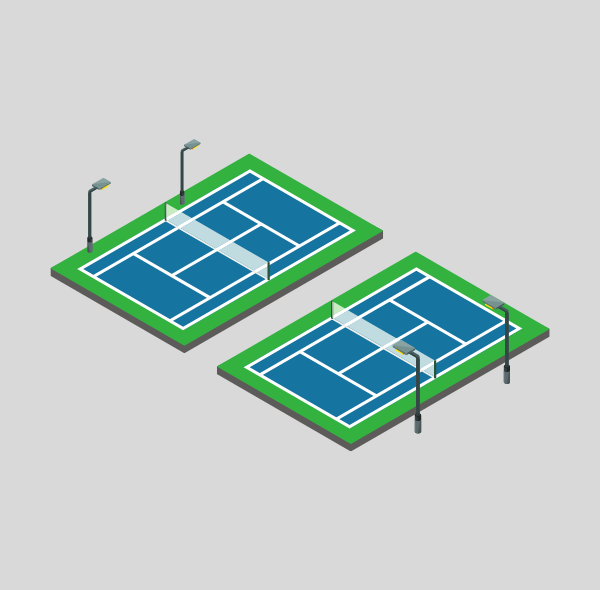
Two tennis court LED
lighting layout with
4 poles
Two tennis court LED lighting layout with 4 poles
The cost of the tennis court layout described below typically costs somewhere between $60,400 and $466,400 depending on the quality of the LED lighting fixutres and geographical differences.
Level of competition
Recreational
Brightness (fc/lux)
30 fc / 300 lux - 50 fc / 500 lux
Light pole height
20- 26 feet
Light temperature
Above 2000K
Uniformity
Above 0.6
Glare
Less than 55
Color rendering index
Above 20

Single tennis court LED
lighting layout with
4 poles
Single tennis court LED lighting layout with 4 poles
The cost of the tennis court layout described below typically costs somewhere between $30,200 and $233,200 per court depending on the quality of the LED lighting fixutres and geographical differences.
Level of competition
Recreational
Brightness (fc/lux)
30 fc / 300 lux - 50 fc / 500 lux
Light pole height
20- 26 feet
Light temperature
Above 2000K
Uniformity
Above 0.6
Glare
Less than 55
Color rendering index
Above 20
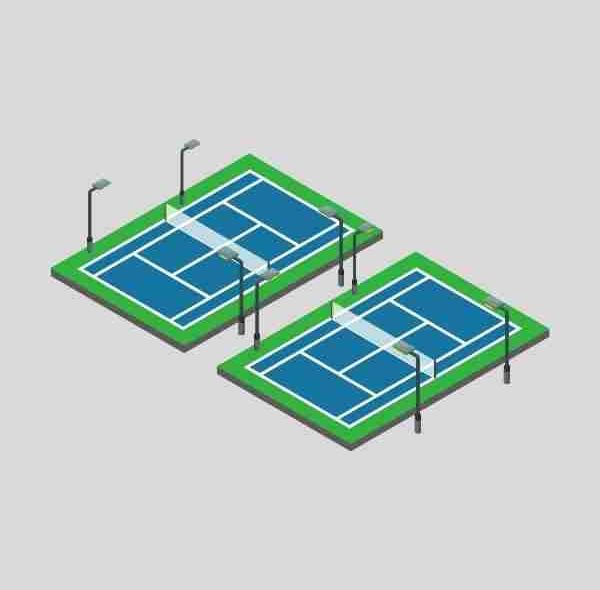
Two tennis court LED
lighting layout with
8 poles
Two tennis court LED lighting layout with 4 poles
The cost of the tennis court layout described below typically costs somewhere between $60,400 and $466,400 depending on the quality of the LED lighting fixutres and geographical differences.
Level of competition
Recreational
Brightness (fc/lux)
30 fc / 300 lux - 50 fc / 500 lux
Light pole height
20- 26 feet
Light temperature
Above 2000K
Uniformity
Above 0.6
Glare
Less than 55
Color rendering index
Above 20
Outdoor LED Tennis Court Lighting Layout - High school

Single tennis court LED
lighting layout with
6 poles
Single tennis court LED lighting layout with 6 poles
The cost of the tennis court layout described below typically costs somewhere between $30,200 and $233,200 depending on the quality of the LED lighting fixutres and geographical differences.
Level of competition
High school, private club
Brightness (fc/lux)
50 fc / 500 lux - 75 fc / 750 lux
Light pole height
26 - 40 feet
Light temperature
above 4000K
Uniformity
Above 0.7
Glare
Less than 50
Color rendering index
Above 65
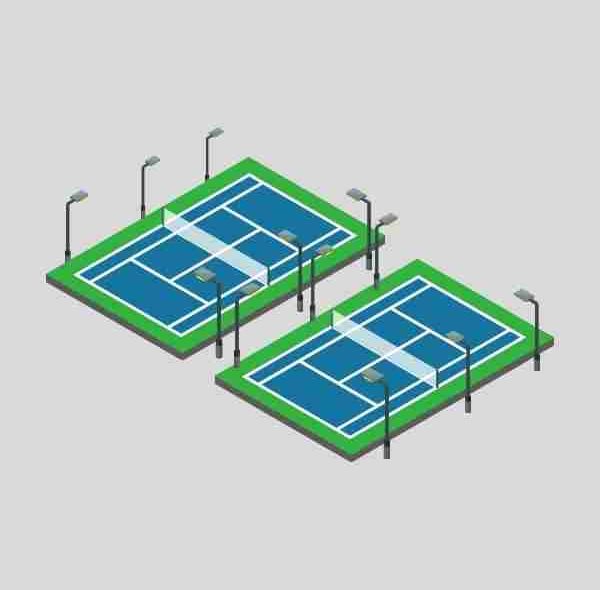
Two tennis court LED
lighting layout with
12 poles
Two tennis court LED lighting layout with 6 poles
The cost of the tennis court layout described below typically costs somewhere between $60,400 and $466,400 per court depending on the quality of the LED lighting fixutres and geographical differences.
Level of competition
High school, private club
Brightness (fc/lux)
50 fc / 500 lux - 75 fc / 750 lux
Light pole height
26 - 40 feet
Light temperature
above 4000K
Uniformity
Above 0.7
Glare
Less than 50
Color rendering index
Above 65
Outdoor LED Tennis Court Lighting Layout - College and professional level

Single tennis court LED
lighting layout with
8 poles
Single tennis court LED lighting layout with 8 poles
The cost of the tennis court layout described below typically costs somewhere between $30,200 and $233,200 per court depending on the quality of the LED lighting fixutres and geographical differences.
Level of competition
College, Professional
Brightness (fc/lux)
75 fc / 750 lux - 125 fc / 1250 lux
Light pole height
50- 66 feet
Light temperature
Above 4000K
Uniformity
Above 0.7
Glare
Less than 50
Color rendering index
Above 80
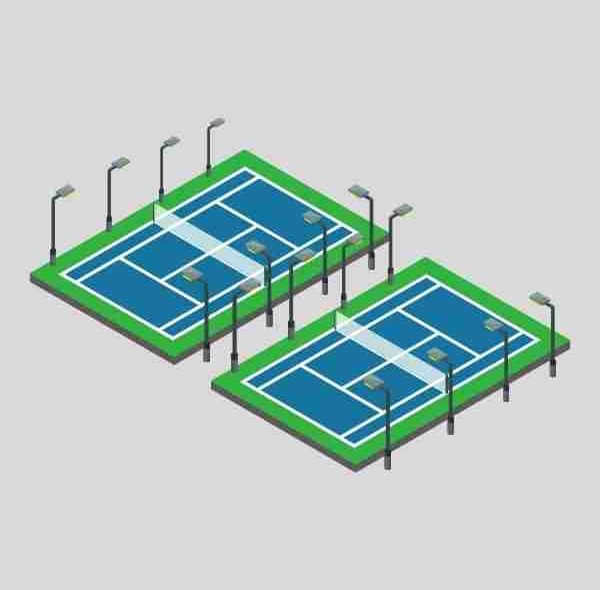
Two tennis court LED
lighting layout with
16 poles
Two tennis court LED lighting layout with 8 poles
The cost of the tennis court layout described below typically costs somewhere between $60,400 and $466,400 per court depending on the quality of the LED lighting fixutres and geographical differences.
Level of competition
College, Professional
Brightness (fc/lux)
75 fc / 750 lux - 125 fc / 1250 lux
Light pole height
50- 66 feet
Light temperature
Above 4000K
Uniformity
Above 0.7
Glare
Less than 50
Color rendering index
Above 80
Indoor LED Tennis Court Lighting Layout - Recreational

Indoor LED Tennis Court Lighting Layout - Professional

How many LED lighting fixtures do I need for my indoor tennis court?
Indoor arenas or sports halls typically host several tennis courts under the same roof. The lighting fixtures are fixed to the ceiling above the tennis courts. The number of fixtures you will need for your facility depends on the total area that needs to be lit and the level of competition. See below a typical lighting fixture arrangement for an indoor tennis complex and a simple calculation to give you an idea of how many LED tennis court lighting fixtures are needed.
- LED Lighting fixture efficiency: 130 lumens per watt (LPW)
- Total area to be lit (4 courts): 11,232 square feet
- Lumen output needed (min-max): 336,960 – 1,404,000
- Total wattage needed (min-max): 2600 – 10,800
- For a recreational horse arena, you will need at least 16 x 200-watt LED lighters.
- For a top-level equestrian arena, you will need at least 36 x 300-watt LED lighters.
LED Sports Lighting Buyer's Guide
If you're planning to install or retrofit an LED sports lighting system, our comprehensive buyer's guide covers all the essential aspects including planning, budgeting, design, installation, and post-installation considerations, simplifying your decision-making process.
Get the Free GuideEssential LED Tennis Court Lighting Considerations
Whether you are a sports club owner or an athletics director, you must consider several factors when investing in a tennis court lighting system to get the best results.
Glare
The glare is an intense, blinding light that is unsuitable for playing. Hence, one vital feature that your lighting system needs is anti-glare function. Experienced and professional LED sports lighting contractors equip their LED lights with anti-glare lenses to protect players and help them see things conveniently.
Waterproof
Good LED lights should have proper protection from the elements. This will enable you to use the lights in any environment without worrying about water damage. Our recommendation is to go for LED lights that have an excellent waterproof rating.
Color Temperature
Another vital feature that you must look out for when investing in a tennis court lighting system is color temperature. We recommend that your lighting system offers cool white light of between 5000 to 6000K.
Projection Angle
Asymmetric tennis court lighting is highly versatile. Whatever your lighting needs may be, this lighting system has various beam angles to meet them.
Uniformity
When it comes to proper tennis court lighting, you can’t afford to overlook uniformity. A system with high uniformity will light up the court excellently. We recommend that you opt for between 0.6 to 0.7 uniformity.
Light Controls
Good tennis court lighting systems come with a wireless control feature to give you a smooth user experience. This will enable you to easily turn the lights on and off and track usage in different locations. It will also allow you to adjust the lights as needed.
LED Tennis Court Lighting Cost
The cost of having LED sports lighting on your tennis court will be determined by several factors. Firstly, ask yourself if you are installing a new LED system or upgrading an existing one. A new system will cost you more money. You should also consider the size of the court, the level of competition, and the number of spectators. Finally, you will spend more money on your LED system if TV broadcasting is available. We’ve written at length about tennis court lighting installation costs in a separate post!
Though the cost of installing LED tennis court lighting seems to be higher than other options, there are several grants, rebates, and tax incentives that you can take advantage of. Any of these options will lower your expenses significantly. Check out this article about tennis court and lighting grants to learn more.

LED Tennis Court Lighting Contractors
It is normal to think that you will be saving some money by taking a DIY approach to your LED light installation. However, the service of a contractor is always more beneficial in the long run. Contractors are highly qualified and experienced professionals that only use the best equipment for the job. They also carry out proper photometric analysis and ensure that their installations meet the requirements of their clients. You will get a favorable warranty too.
Get started by using our sports lighting partner finder and get connected with experienced and knowledgeable lighting partners.
Get Your LED Sports Lighting Project Started
We’ve created a comprehensive set of tools designed to assist facility managers and project planners in initiating their projects and connect them with the professionals in the industry.
Get a tailored cost estimate
Try our LED sports lighting cost calculator and get a customized quote in a matter of minutes.
Get a photometric study
Tell us briefly about your project and get a lighting design from a professional lighting company
Find your ideal supplier
Give us the specs of your lighting project and get a list of recommended suppliers from our network.
LED Sports Lighting Buyer's Guide
Our free buyer's guide covers planning, budgeting, design, installation, and post-installation considerations, simplifying your decision-making process.
Find Grants & Funding
Browse through our grants database and find potential funding opportunities for your lighting project.
LED Tennis Court Lighting Q&A
LED lights are the recommended choice for lighting up a tennis court. They offer energy efficiency, long lifespan, and better control over light distribution. LED technology provides excellent lighting quality, reduced maintenance, and potential energy savings compared to traditional lighting options like metal halide lamps. Consider factors such as lighting uniformity and compliance with regulations when selecting the LED lighting for your tennis court. Consulting with lighting professionals can help determine the best solution for your specific needs.
For a standard-sized tennis court, which measures 78 feet in length and 36 feet in width, the lighting should provide sufficient illumination across the entire playing area (2808 square feet). The recommended light levels for tennis courts typically range between 20 and 125 foot candles (lumens per square foot), depending on the level of play and competition.
Therefore, a recreational tennis court requires around 56,000 lumens. A collegiate level tennis court has higher lighting requirements and it will need approx. 280,000 lumens.
The control panel for LED tennis court lights serves as the central operational hub of the lighting system. Typically situated in a secure area, it offers switches for light control, including possible adjustments for brightness and timer settings. Advanced systems may incorporate digital touch screens, remote control capabilities, and smartphone app integration. Safety measures such as circuit breakers protect against electrical faults. Regular inspections are necessary to ensure the control panel functions properly. For specific information about your system, consult the user manual or seek guidance from a professional.
Traditional lighting technologies such as metal halide lamps typically range from 400 watts to 1000 watts per fixture. These high-intensity discharge (HID) lamps provide bright illumination but consume more energy compared to newer lighting options.
LED (light-emitting diode) lights have gained popularity for tennis court lighting due to their energy efficiency and longer lifespan. LED fixtures for tennis courts generally range from 100 watts to 400 watts per fixture, while still providing excellent lighting quality and visibility.
Indoor LED tennis court lighting offers numerous advantages over metal halide lighting. LED lights are highly energy-efficient, have a longer lifespan, provide instant illumination, offer superior light quality with reduced glare, and can be dimmed as needed. They require less maintenance and are environmentally friendly. LED lighting ensures consistent performance and delivers cost savings in terms of energy consumption and maintenance efforts for indoor tennis courts.
To change tennis court light bulbs, turn off the power, safely remove the old bulb, insert the new bulb, and test it before securing the fixture.
LED lights do not need frequent replacement due to their long lifespan and durable design, resulting in reduced maintenance and costs.
The height of tennis court lights can vary depending on various factors, including the lighting requirements, court size, and surrounding environment. In general, the light poles for tennis courts can range in height from 20 to 40 feet (6 to 12 meters) or more.
For indoor tennis courts, the height of the lights is typically lower compared to outdoor courts. Since the ceiling height in indoor facilities is generally lower, the lights are positioned at a height that allows for adequate illumination without interfering with the space or obstructing the ball’s trajectory. A commonly recommended minimum ceiling height for indoor tennis courts is around 24 feet (7.3 meters).




